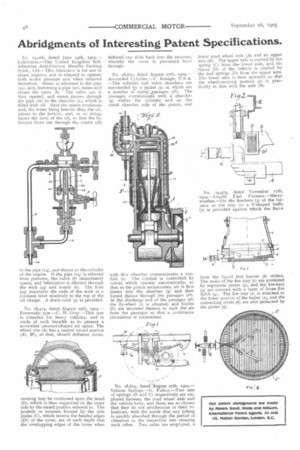Abridgments of Interesting Patent Specifications.
Page 16

If you've noticed an error in this article please click here to report it so we can fix it.
No. 13,066, dated June 24th, 1905.Lubricator.—The United Kingdom Self. AdjustingAnti-Friction Metallic Packing Synd., Ltd.—This lubricator is for use in steam engines, and is adapted to operate both under pressure and when relieved therefrom. Steam is admitted to the pipe (141, and, traversing a pipe (to), raises and closes the valve (8). The valve (so) is then opened, and steam passes through the pipe (i6) to the chamber (t), which is filled with oil. Here the steam condenses and, the water being heavier than the oil, passes to the bottom, and, in so doing, raises the level of the oil, so that the lubricant flows out through the nozzle (i8) to the pipe (14), and thence to the cylinder of the engine. If the pipe (14) is relieved from pressure, the valve (8) immediately opens, and lubrication is effected through the wick (23) and nozzle (f)). The float (25) maintains the ends of the wick at a constant level relatively to the top of the oil charge. A drain cock (5) is provided.
No. 18,424, dated Kugust 25th, 1904.– Pneumatic tyre.—C. H. Gray.—This tyre is intended for heavy vehicles, and is made of such breadth as to present a somewhat crescent-shaped air space. The wheel rim (A) has a central raised portion (Al, B2), so that, should deflation occur, running may be continued upon the tread (D), which is then supported on the inner side by the raised portion referred to. The pockets or recesses formed by the side plates (Cl, which receive the beaded edges (D2) of the cover, are of such depth that the overlapping edges of the cover when
deflated can slide back into the recesses, whereby the cover is prevented from damage.
No. 18,607, dated August 27th, lei:M.-Air-cooled Cylinder.—F. Reaugh, —The cylinder and valve chambers are surrounded kya jacket (a) in which are a number of spiral _passages (al). The passages communicate with a chamber (g) within the cylinder and on the crank chamber side of the piston, and with this chamber communicates a conduit W. The conduit is controlled by valves which operate automatically, so that as the piston reciprocates, air is first drawn into the chamber (g.) and then forced thence through the passages (a2I. At the discharge end of the passages (all the fly-wheel (l) is situated, and blades (11) are mounted thereon to suck the air from the passages so that a continuous circulation is maintained.
No. x8,605, dated August 27th, 1904.— Vehicle Springs.—G. Fulton.—Two sets of springs ID and C) respectively are employed between the road wheel axle and the vehicle body, and these are so chosen that they do not synchronise in their vibrations, with the result that any jolting is quickly absorbed through the period of vibration in the respective sets crossing each other. Two axles are employed, a
lower road wheel axle (A) and an upper axle (B). The upper axle is carried by the spring (C) from the lower axle, and the frame 110 of the vehicle is carried by the leaf springs (D) from the upper axle. The lower axle is bent upwards so that the wheel-carrying portion (a) is practically in line with the axle (B).
No 24,97e, dated November t7tb, leo4.—Liquid Fuel Furnace.—Merryweather.—On the fire-bars (3) of the furnace or fire tray (1) a V-shaped baffle (7) is provided against which the flame from the liquid fuel burner (8) strikes. The walls of the fire tray (1) are protected by segmental plates (5), and the fire-bars (3) are covered with a layer of loose fire brick (4). The fire tray (I) is attached to the lower portion of the boiler (2), and the connecting rivets (6) are also protected by the plates (5).
















